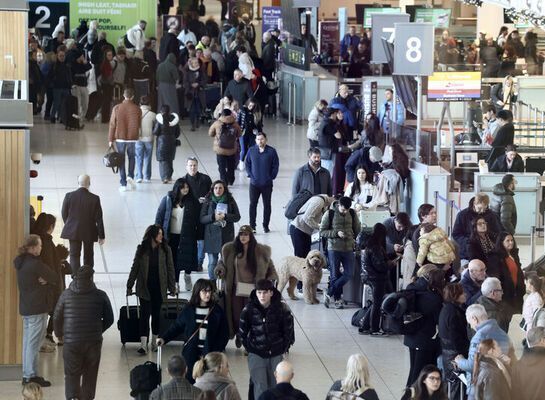Though they lie on different continents and are separated by the Atlantic Ocean, New York City and Dublin have recently been dealing with many of the same issues. Both cities are trying to cope with a massive wave of migrants unparalleled in recent history. A toxic combination of political instability, criminal violence and warfare has unleashed the highest levels of migration in the Western Hemisphere since World War II.
According to the United States State Department, more than 20 million people in the Western Hemisphere are displaced from their homes. Ireland has accepted more than seventy-five thousand Ukrainian refugees, as well as thousands of others from Africa, the Middle East and Asia. New York City has also struggled to accept similar numbers of refugees and migrants. The human waves arriving in Dublin and New York City have exacerbated chronic housing shortages, and homelessness, as well as leaving city governments to deal with a massive influx of people.
New York City is inundated with a surge in Venezuelan, Haitian, Cuban and Central American migrants. In the previous year, more than 57,000 asylum seekers came through New York’s already overstretched shelter system, and migrants are still arriving at a rate of about 200 people a day. The city had taken over 103 hotels as emergency shelters. More than 14,000 migrant children had been enrolled in public schools. Calling it “one of the largest humanitarian crises that this city has ever experienced,” New York City Mayor Eric Adams said that the cost of assisting the new arrivals had soared to $4.3 billion, forcing him to make across-the-board budget cuts in other city services. The city, under Mayor Adams, has spent over a billion dollars to house the migrants since they started arriving in large numbers in the spring of 2022. It expects to spend over $4 billion by next year.
The migrant influx has exacerbated an already serious problem in New York City with homelessness. Currently, about 1 in 80 people in the nation’s largest city do not have a permanent place to live. For the first time in New York City history, the homeless population exceeds 100,000 people in homeless shelters. Days earlier, the city announced that the number of migrants in shelters had passed 50,000 and that, for the first time, they comprise the majority people in city homeless shelters.
The Russian invasion of Ukraine has had a profoundly negative effect on Dublin in particular, and Ireland as a whole. With a memory of the famine and an awareness that millions of Irish people were forced to emigrate, Ireland initially warmly welcomed Ukrainian refugees; however soon Irish people saw the effects of this massive inflow of people was creating problems similar to those in New York. The European Union passed a directive in 2001 after the Balkan wars of the 1990s that stipulated member countries had to accept a potential future refugee influx, but until Russia invaded Ukraine last year, the directive had no effect on countries like Ireland. Ireland has welcomed tens of thousands of Ukrainians fleeing the war in their country offering almost the same access to housing, work, healthcare, and education as Irish citizens under the European Union's the Temporary Protection Directive. Ireland is providing hotel rooms to tens of thousands of Ukrainians - some 51,000 - at a considerably higher cost - €385 million just between March and December last year. Another 5,700 were in homes offered by the public, while the rest of the 70,000 Ukrainians in Ireland were renting their own housing or living with family and friends The total expenditure on welfare support for Ukrainians under the Temporary Protection Directive was just over €240 million in 2022. The total bill for accommodating Ukrainian refugees in hotels has reached €605 million with no end in sight.
The massive financial assistance to Ukrainians has stoked anger in Dublin. While the government is providing hotel rooms to Ukrainians, more than nine thousand people in Dublin sleep rough and that number is expected to grow. A stroll along O’Connell Street reveals dozens of people curled up in doorways in sleeping bags. Many Irish citizens wonder how the government can do so much to house migrants, yet allow thousands of Irish citizens to remain homeless, especially in light of the fact that the Irish government has a €16 billion surplus.
Syrian and other Middle Eastern refugees have also arrived in Dublin, but get far less help than the Ukrainians. Tent cities of these refugees have become a feature of the Dublin landscape and sadly a tent city in the city center was attacked and burned by anti-migrant protestors in May. Though the crisis is acute at the moment, it could even get far worse. The Irish Government has been warned that up to 180,000 people could be seeking refuge in Ireland by the end of the year, according to briefing material for Government Chief Whip Hildegarde Naughton, which was released following a Freedom of Information request.
The shortage of accommodation caused by the migrant influx has driven up the cost of housing for Irish people of modest financial means, making it hard for working class Dubliners to make ends meet. The shortage of hotel rooms has also driven up the cost of accommodation for Dublin’s millions of tourists, discouraging foreign tourists from visiting the capital and infusing money into the local economy.
Many Irish people react with anger when they learn that Ireland has taken a far higher percentage of Ukrainian refugees than other European Union members. The latest official figures show that Ukrainian refugees account for 1.5 per cent of the population in Ireland compared to 0.2 per cent of the population in France and 0.5 per cent in Sweden. Brian Stanley, a Sinn Féin TD, said he wanted to find out why some other European countries are taking fewer Ukrainian refugees per head of population than Ireland. “Are they all shouldering their fair share and is that being flagged up at European level?” he asked.

A scene on a lane just off Sandwith Street Upper, in Dublin, where reports suggest that there was a fire after a protest between groups in support of refugees living in the lane and those opposed to them. [Sasko Lazarov/Rolling News.ie]
With no end of the war in Ukraine in sight and 10s of thousands of more refugees arriving in Ireland, the crisis will not end anytime in the foreseeable future. New York City will also continue to feel the effects of the massive influx of people from Latin America and the Caribbean, as there is no end in sight to the problems driving people to the Big Apple. Both Dublin and New York City will strain to solve the problems caused by this unprecedented movement of people around the globe.








